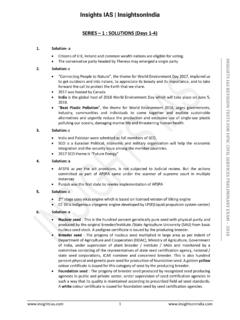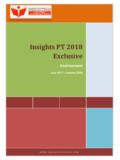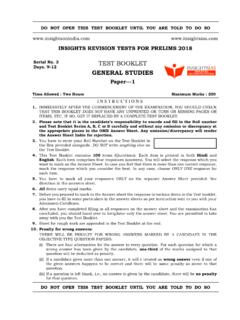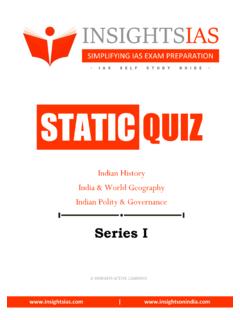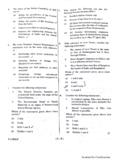Transcription of Insights IAS | InsightsonIndia
1 Insights IAS | InsightsonIndia 1 Insights IAS REVISION TESTS FOR UPSC CIVIL SERVICES PRELIMINARY EXAM 2018 SERIES 3 : SOLUTIONS (Days 9-12) 1. Solution: d Answer Justification: In 2016, Compensatory Afforestation Fund Act (CAMPA), 2016 was passed by Parliament to ensure expeditious and transparent utilization of compensatory levies realized in lieu of forest land diverted for non-forest purpose, which presently is of the order of about Rs. 49,000 crore. Therefore statement 1 is correct. Source: MoEF Report Highlights of the CAMPA act: The Bill establishes the National Compensatory Afforestation Fund under the Public Account of India, and a State Compensatory Afforestation Fund under the Public Account of each state. These Funds will receive payments for: (i) compensatory afforestation, (ii) net present value of forest (NPV), and (iii) other project specific payments. The National Fund will receive 10% of these funds, and the State Funds will receive the remaining 90%.
2 These Funds will be primarily spent on afforestation to compensate for loss of forest cover, regeneration of forest ecosystem, wildlife protection and infrastructure development. Therefore, statement 2 is correct. The Bill also establishes the National and State Compensatory Afforestation Fund Management and Planning Authorities to manage the National and State Funds. Therefore, statement 3 is correct Source: 2. Solution: b Answer Justification: From the below source refer the guidelines (as per the sections provided in the document). GUIDELINES FOR ECOTOURISM No new tourist facilities are to be set up on forest lands. This is in compliance with the Wildlife (Protection) Act, 1972, and the directives of the Honourable Supreme Court. Therefore, statement 1 is incorrect. The State Forest Department should be the arbiter in case of any dispute regarding the ecological advisability of any tourism plans, whether Protected Area Management, private entity, temple board or community, as the welfare of wildlife and Protected Areas/ biodiversity takes precedence over tourism.
3 Therefore statement 2 is correct. Source: Insights IAS | InsightsonIndia 2 Insights IAS REVISION TESTS FOR UPSC CIVIL SERVICES PRELIMINARY EXAM 2018 3. Solution: a Answer Justification: CoP-10 to the CBD in October 2010 had adopted a Strategic Plan for Biodiversity for 2011-2020, with five goals and 20 Aichi Targets, as an ambitious plan developed with the purpose of inspiring broad-based action in support of biodiversity over the decade by all countries and stakeholders. The Strategic Plan and Aichi Targets are the overarching framework on biodiversity not only for CBD and biodiversity related conventions, but for the entire UN system. The UN General Assembly vide a resolution has declared 2011-2020 as the UN Decade on Biodiversity, coinciding with the duration of the Strategic Plan. Accordingly, India through an extensive consultative process, has developed 12 national biodiversity targets along with indicators for monitoring, using Aichi targets as a framework, and brought out a National Biodiversity Action Plan Addendum 2014 to NBAP 2008.
4 Therefore, statement 1 is correct. All targets don t have 2020 as a target year. Example: Target 9: By 2015, Access to Genetic Resources and the Fair and Equitable Sharing of Benefits Arising from their Utilization as per the Nagoya Protocol are operational, consistent with national legislations. Therefore, statement 2 is incorrect. Sources: 4. Solution: a Answer Justification: Amur falcon (eastern red-footed falcon) Raptor It breeds in south-eastern Siberiaand Northern China before migrating in large flocks across India and over the Arabian Sea to winter in Southern Africa. Amur falcons come to roost at Nagaland (Doyang Lake) during their flight from Mongolia to Africa. Amur Falcon Conservation: Migratory Amur Falcons visiting Nagaland were hunted. With support of people in the region, the Government was successful in drastically reducing the hunting of the birds.
5 The birds have also been satellite tagged and movement tracked. Statements 1 and 2 are correct. Statement 3 is incorrect because the hunting was observed in Nagaland as per the report. Source: 5. Solution: d Insights IAS | InsightsonIndia 3 Insights IAS REVISION TESTS FOR UPSC CIVIL SERVICES PRELIMINARY EXAM 2018 Answer Justification: Wetlands (Conservation and Management) Rules, 2017. Restrictions of activities in wetlands. (1) The wetlands shall be conserved and managed in accordance with the principle of wise use as determined by the Wetlands Authority. (2) The following activities shall be prohibited within the wetlands, (i) Conversion for non-wetland uses including encroachment of any kind. (ii) Setting up of any industry and expansion of existing industries. (iii) Manufacture or handling or storage or disposal of construction and demolition waste, hazardous substances, electronic waste. (iv) Solid waste dumping.
6 (v) Discharge of untreated wastes and effluents from industries, cities, towns, villages and other human settlements. (vi) Any construction of a permanent nature except for boat jetties within fifty metres from the mean high flood level observed in the past ten years calculated from the date of commencement of these rules. (vii) Poaching. All 3 statements are correct. (C&M)%20 Rules,% 6. Solution: d Answer Justification: In a major success in the fight against wildlife crime, Wildlife Crime Control Bureau (WCCB), Ministry of Environment, Forest and Climate Change, coordinated OPERATION THUNDER BIRD in India, from January 30-February 19, 2017. Operation Thunderbird is the codename for INTERPOL s multi-national and multi-species enforcement operation. The operation is not species-specific. Therefore, statement 1 is not correct. The operation is co-ordinated by WCCB, not AWBI. So, statement 2 is too incorrect.
7 7. Solution: c To encounter the menace of the illegal trade through e-commerce platform, WCCB organized and coordinated an enforcement operation named Operation Wildnet to tackle illegal Wildlife trade through internet using Social Media Platforms such as Facebook, Twitter, Whatsapp, Wechat etc. apart from various online classified sites and trade portals, websites and Blog Spots. Source: (C&M)%20 Rules,% 8. Solution: b In 1972 there were an estimated 1827 tigers. Now the figure stands at 2226 in 2016. The number of tiger reserves has increased to 50 from 9 in 1973. We have 2/3rd of wild tigers of the world in our country. Tiger is at the apex of the forest ecosystem and depicts the health of our jungles. That is why tigers are called indicator species. There are 2/3rd of wild tigers of the world in India, not 1/3rd. So, statement 1 is incorrect. Other statements are correct.
8 Insights IAS | InsightsonIndia 4 Insights IAS REVISION TESTS FOR UPSC CIVIL SERVICES PRELIMINARY EXAM 2018 Being the dominant predators of the ecosystem (So, statement 2 is correct), they ensure that the numbers of herbivores like deer are kept balanced. A steep fall in tiger population could lead to a rise in herbivore population, which could potentially destroy forests by consuming the trees and plants So, statement 3 is correct Source: 9. Solution: c Coral Reef Restoration at Gulf of Kachchh by ZSI is a successful and first of its kind attempt in the world to restore coral species which have become extinct at Gulf of Kachchh about 10 thousand years ago. Significant area of degraded reefs has been restored with branching coral species belonging to family Acroporidae, which are the dominant reef contributors in all world reefs. Coral Sanatorium for Global warming affected corals (coral refugia), coral spawning and discovery of dugong are some of the outcomes of the project.
9 So, both statements are correct. Source: 10. Solution: c Answer Justification: A pilot initiative of electronic surveillance ( e-Eye ), using long range, intelligent thermal and infrared cameras, has been implemented in the southern part of the Corbett Tiger Reserve for round the clock surveillance. This facility would be extended to other Tiger Reserves. It is used for surveillance not just in low vision but round the clock. So, Statement 2 is incorrect. Statement 1 is correct. The e-surveillance cameras can scan 360 degrees and track animal and human movement. It is an excellent tool for checking poaching as well as studying the migratory route of the big jumbos. Statement 3 is also correct. Source: 11. Solution: c Green India Mission has a goal inter alia: To improve/enhance eco-system services like carbon sequestration and storage (in forests and other ecosystems), hydrological services and biodiversity; along with provisioning services like fuel, fodder, and timber and non-timber forest produces (NTFPs).
10 The Millennium Ecosystem Assessment (MA) report 2005 defines Ecosystem services as benefits people obtain from ecosystems and distinguishes four categories of ecosystem services Supporting services, Provisioning services, Regulating services and Cultural Insights IAS | InsightsonIndia 5 Insights IAS REVISION TESTS FOR UPSC CIVIL SERVICES PRELIMINARY EXAM 2018 services. Regulating services include carbon sequestration and climate regulation, waste decomposition and detoxification, purification of water and air, pest and disease control. Source: 12. Solution: a It is the first attempt in India to protect and restore a sinking island. Deployment of artificial reefs parallel to the sinking island in the seaward side reduces the effect of currents and waves, enhances fish habitats for higher fish production and protection of fish diversity. Natural corals get attached to artificial reefs over time and start regeneration.
